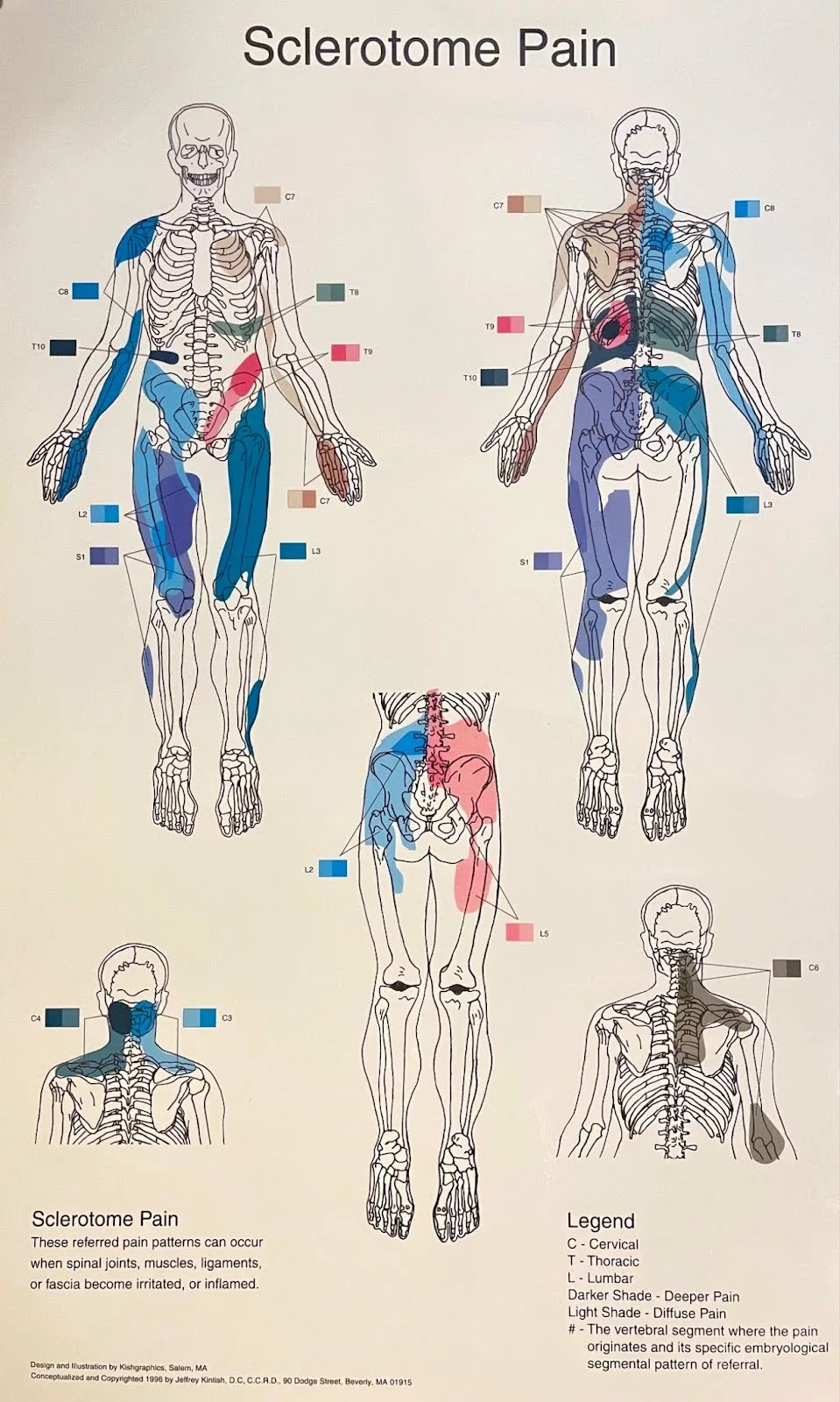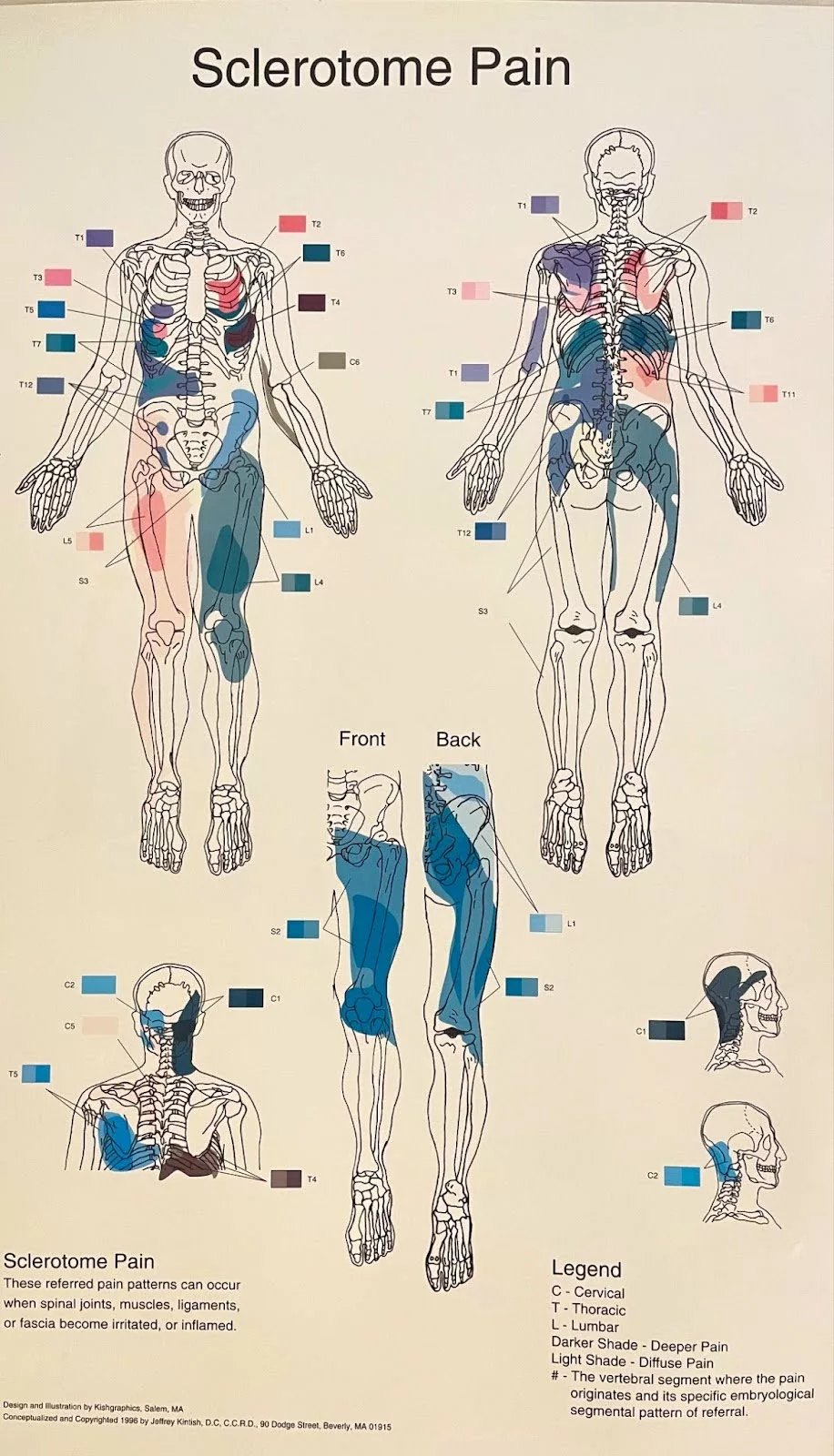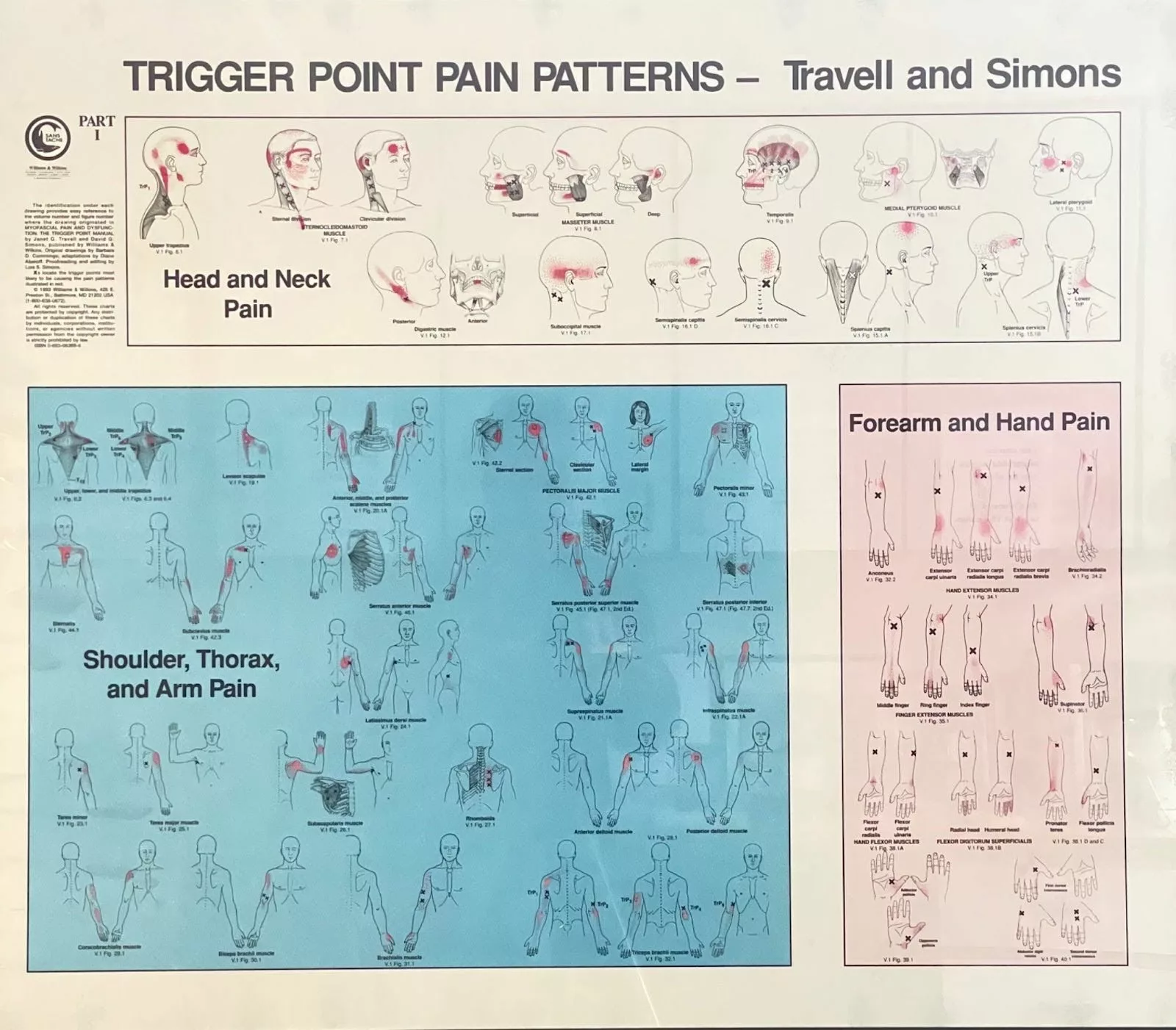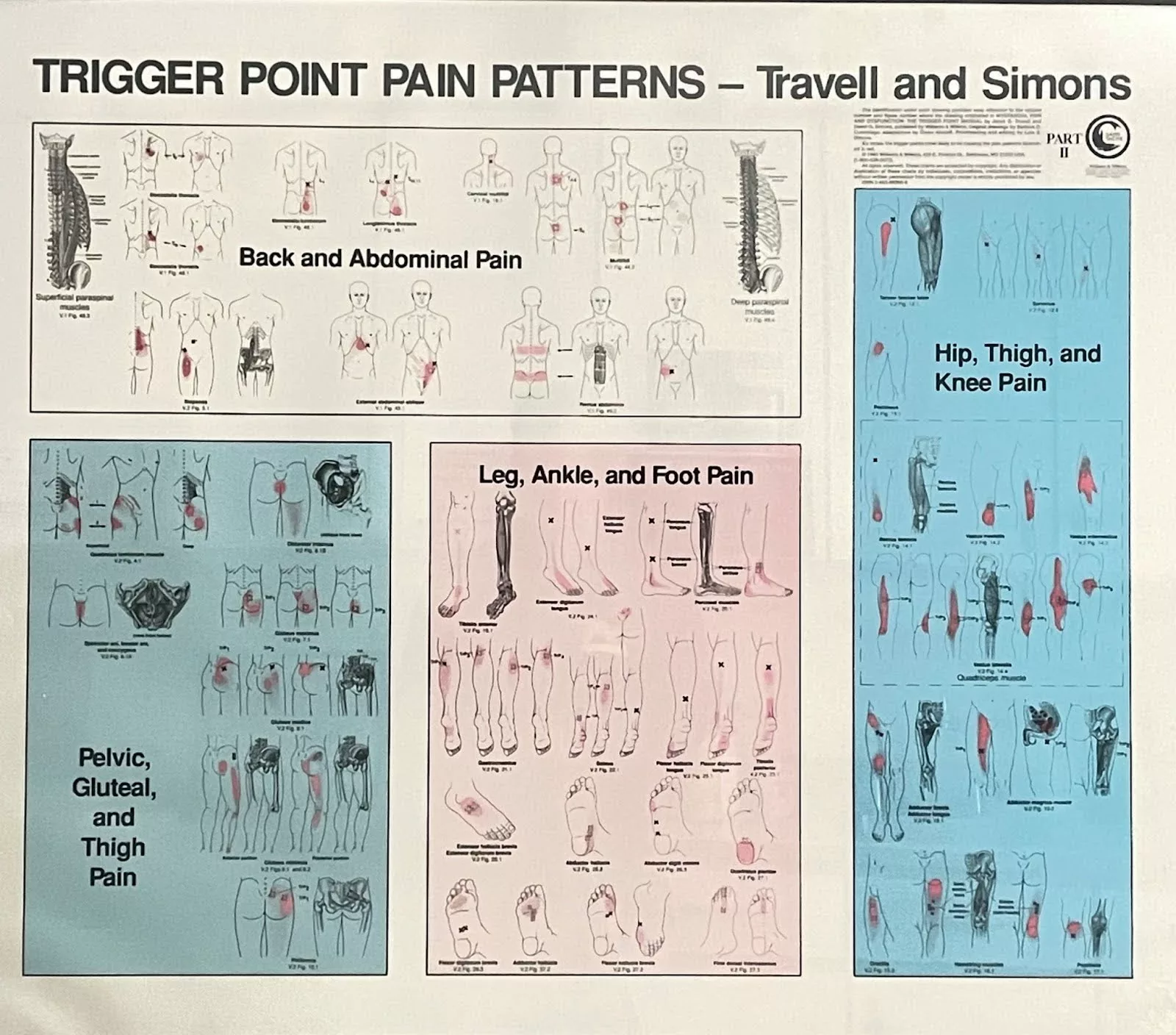What is Back & Neck Pain?
A spinal vertebra that has lost its normal motion can become inflamed and create very specific patterns of spine pain termed Sclerotome Pain. A secondary condition often arises in the adjacent muscles of the spine in which these become tight and painful. The term for the muscle pain in the spine is termed myofascial pain or trigger point pain.
What Are The Causes of Back & Neck Pain?
Sclerotome pain patterns originate from inflamed and dysfunctional spinal segments. There are 24 spinal vertebrae consisting of 7 cervical, 12 thoracic, and 5 lumbars. Additionally there are 2 sacroiliac joints in the pelvis. Each segment has its own pattern of sclerotome pain that can occur locally or extend far out from the source. These patterns of pain have been studied extensively by medical researchers who have mapped out diagrams seen in the charts below.
Overloading the spine, lifting heavy objects, repetitive movements all day in a work setting, prolonged sitting or driving, sports injuries, loss of core muscle strength, slips, falls, accidents, obesity and smoking all contribute to the onset of back pain.


What Are The Signs And Symptoms of Back & Neck Pain?
Pain in any part of the back, neck, shoulders, hips, arms or legs can be a part of back pain. Other organic conditions can also cause back pain that may require medical intervention. A thorough history and examination can determine the source of pain.
What Are The Risk Factors of Back & Neck Pain?
Pain is the body’s warning system that something is wrong. Other possible reasons for your complaints must be evaluated by a complete medical history and examination.
How is Back & Neck Pain Diagnosed?
A specific method called motion palpation is used to determine the cause of spine pain. Neurologic and orthopedic testing is also performed along with myofascial palpation. If it is determined that your condition is not a chiropractic case. Every effort will be made to promptly refer you to the right medical provider.
What Are Possible Treatments For Back & Neck Pain?
Adjustments
The adjustment is a safe, natural, noninvasive procedure used by the chiropractor to restore and improve health. Learning the art of adjusting is a skill that requires years of study and practice. Chiropractic doctors are the only health care professionals trained to deliver the chiropractic adjustment. Spinal adjustments by any other individual or health care professional have been shown to be dangerous and less effective. Chiropractic training starts with a four year undergraduate program in premedical sciences then four additional years at chiropractic college leading to a Doctorate of Chiropractic degree. There are many post graduate programs offering even more advanced training.
What Is A Spinal Adjustment?
The spinal adjustment or spinal manipulation refers to the process in which the doctor of chiropractic skillfully applies controlled force into one or more vertebrae of the spine which have lost their normal motion. The current terminology to describe this condition is Segmental Dysfunction. Older theories of misalignment and subluxation are no longer considered valid. A spinal vertebra that has lost its normal motion can become inflamed and create very specific patterns of spine pain termed Sclerotome Pain. A secondary condition often arises in the adjacent muscles of the spine in which these become tight and painful. The term for the muscle pain in the spine is termed myofascial pain or trigger point pain. The adjustment is also frequently used in the pelvic region to normalize motion in the sacroiliac joints. The adjustment is usually delivered using the hands or through the use of a specialized mechanical tool.
When Should Spinal Adjustments Be Given?
Spinal adjustments are applied to specific vertebrae of the spine which no longer have proper motion. The chiropractor uses a procedures called motion palpation to determine which, if any, vertebrae are affected. If are found, immediate correction is generally indicated. Since like cavities spine dysfunction is not always painful during the initial stages, even those who are not experiencing back or neck discomfort often benefit from periodic spinal checkups.
Numerous studies have demonstrated chiropractic care provides outstanding results in alleviating sclerotome pain and secondary myofascial pain
FYI
Did your mother ever warn you that “cracking” your knuckles would give you arthritis? If she did, we’re sorry to say that she was wrong! Research has actually shown that individuals who habitually “crack” their knuckles over their lifetime actually lower the incidence of arthritis in their knuckles compared with those who do not. Researchers believe the knuckle “cracking” increases joint nutrition and maintains joint motion, both of which are essential for a healthy joint.
Are There Preventative Steps or Measures To Avoid Back & Neck Pain?
Individually designed stretching and spinal rehabilitation exercise can help to prevent back pain. If you are overweight, one must work hard to lose the weight and take off the stress on the spine. Smoking is well documented to be a common cause of back pain. If you want your back to feel good, stop immediately.
What Are The Risks If Back & Neck Pain Is Left Untreated?
Hope is not a very good strategy that untreated back pain will resolve on its own. Rarely does this occur. Repeated and worsening exacerbations of increased frequency are usually the result of ignoring the pain. In the same way that a cavity in a tooth can exist for weeks or months before the decay crosses the threshold into pain, the same is true for spine pain.
Are There Other Related Conditions To Back & Neck Pain?
Yes, it is common for neck pain, headaches, arm pain, leg pain and muscle/myofascial pain to develop as a consequence of back pain.
Myofascial pain is a common secondary source of pain. The original research came from Janet Travell, M.D. who was the personal White House physician to President John F. Kennedy. Dr. Tatone has personally met and studied under Dr. Travell and employs her diagnosis and treatment methods. Dr. Travell herself employed spinal manipulation in order to help alleviate muscle pain and dysfunction.


Recommended Next Steps
Our office is prepared to diagnose and treat back and muscle pain. Early intervention can result in quicker recovery times.
